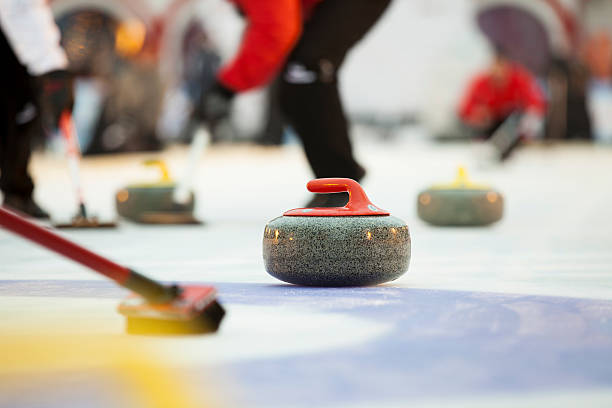Decoding the Intricacies of Curling: The Chess of Winter Sports
Curling, often dubbed the 'chess on ice', is a sport that combines strategy, precision, and teamwork in a unique frozen arena. This centuries-old game, originating in medieval Scotland, has evolved into an Olympic favorite, captivating audiences worldwide with its blend of physical skill and tactical acumen. Despite its growing popularity, curling remains shrouded in mystery for many, its nuances and strategies often misunderstood or overlooked. This article delves deep into the world of curling, unraveling its complexities and showcasing why it's more than just sweeping ice.

The game is played between two teams of four players each, with each team taking turns to deliver eight stones. The objective is to have more stones closer to the center of the target area, known as the ‘house’, than the opposing team at the conclusion of each end. An ‘end’ in curling is similar to an inning in baseball, with a typical game consisting of eight or ten ends.
The roles within a curling team are highly specialized. The ‘skip’ acts as the team’s strategist and captain, directing play from the house end of the sheet. The ‘lead’ throws the first two stones of each end, setting the stage for the team’s strategy. The ‘second’ and ‘third’ (also known as the ‘vice-skip’) fill in the middle, each throwing two stones and playing a crucial role in both offensive and defensive strategies.
The Art and Science of Sweeping
Sweeping, often the most visually striking aspect of curling, is far more than just vigorous housekeeping on ice. It’s a crucial technique that can alter the path and distance of a stone, making the difference between a winning shot and a missed opportunity. When a stone is thrown, two sweepers move alongside it, ready to act on the skip’s command.
The physics behind sweeping is fascinating. As sweepers brush the ice in front of the moving stone, they create friction, which briefly melts the top layer of ice. This thin layer of water reduces the stone’s deceleration and can help it travel up to 15 feet farther than it would without sweeping. Moreover, sweeping can affect the stone’s curl – the sideways movement caused by the stone’s rotation.
Recent advancements in sweeping techniques and equipment have led to controversies and rule changes in the sport. The introduction of directional fabrics and brush heads that could manipulate the ice surface more aggressively led to a ‘sweeping summit’ in 2016, resulting in new regulations to maintain the integrity of the game.
Strategy and Tactics: The Mental Game
While the physical aspects of curling are crucial, it’s the strategic elements that truly set the sport apart. Often compared to chess, curling requires players to think several moves ahead, considering not just their immediate shot but how it will set up future opportunities or defend against opponent’s plays.
The ‘hammer’, or the advantage of throwing the last stone in an end, plays a pivotal role in strategy. Teams with the hammer often play more aggressively, aiming to score multiple points, while teams without the hammer may focus on defensive play, forcing their opponents to score only one point and thus gain the hammer for the next end.
Stone placement is a delicate balance between offense and defense. Guards (stones placed in front of the house to protect scoring stones), draws (stones placed in the house), and takeouts (shots aimed at removing opponent’s stones) are all tools in a curler’s strategic arsenal. The ability to read the ice, anticipate how stones will curl, and adjust strategy as the end progresses separates elite curlers from amateurs.
The Evolution of Curling: From Scottish Lochs to Olympic Arenas
Curling’s journey from a pastime on frozen Scottish lochs to an Olympic sport is a testament to its enduring appeal. The first written evidence of curling dates back to 1541 in Scotland, where the sport was played on frozen ponds and lochs. The oldest curling club still in existence, the Kilsyth Curling Club, was established in 1716.
The sport spread with Scottish emigrants, taking root in countries with similar climates. Canada, in particular, embraced curling, and it has become deeply ingrained in Canadian culture. The Royal Montreal Curling Club, founded in 1807, is the oldest sporting club of any kind in North America.
Curling made its Olympic debut as a demonstration sport in 1924 but wasn’t officially added to the Winter Olympics program until 1998 in Nagano, Japan. Since then, its popularity has grown exponentially, with increased media coverage and investment in facilities and training programs worldwide.
The introduction of arena ice in the 20th century revolutionized the sport, providing consistent playing conditions and allowing for year-round play. This development, coupled with advancements in stone and brush technology, has elevated the level of play and expanded curling’s global reach.
The Global Curling Landscape: Beyond the Traditional Powerhouses
While countries like Canada, Sweden, and Scotland have long dominated the international curling scene, the sport’s global footprint is expanding rapidly. Nations not traditionally associated with winter sports are investing in curling programs, recognizing its accessibility and strategic depth.
China, for example, has made significant strides in curling, winning Olympic medals and hosting major international competitions. The country’s success has inspired other Asian nations to develop their curling programs, with Japan and South Korea also emerging as competitive forces.
In Europe, countries like Italy and the Netherlands are challenging the traditional Nordic dominance, while curling is gaining traction in unexpected places like Brazil and Guyana. This global expansion is not only diversifying the competitive landscape but also bringing fresh perspectives and playing styles to the sport.
The World Curling Federation now boasts over 60 member nations across five continents, a testament to curling’s growing appeal. This global growth has led to the introduction of new competitive formats, such as mixed doubles, which made its Olympic debut in 2018 and has been praised for its fast-paced, dynamic nature.
Curling’s Unique Culture: Sportsmanship and Community
One of curling’s most distinctive features is its strong emphasis on sportsmanship and fair play. The sport is governed by an unwritten code of ethics known as the ‘Spirit of Curling’, which emphasizes respect, honesty, and graciousness in both victory and defeat. It’s common for players to call their own fouls and for games to be played without officials at many levels.
This spirit of sportsmanship extends beyond the ice. The tradition of ‘broomstacking’, where teams socialize together after a match, often sharing a drink or meal, is a cornerstone of curling culture. This practice fosters a strong sense of community and camaraderie among curlers, transcending competitive rivalries.
Curling clubs often serve as social hubs in their communities, hosting events and fostering connections among members of all ages and backgrounds. The sport’s accessibility – it can be enjoyed by people of various ages and physical abilities – contributes to its inclusive nature.
The Future of Curling: Innovations and Challenges
As curling continues to evolve, it faces both opportunities and challenges. The sport is embracing technology, with some tournaments experimenting with sensors in stones and brooms to provide real-time data on stone speed, curl, and sweeping effectiveness. This data not only enhances the viewing experience but also provides valuable insights for training and strategy development.
Virtual reality and online platforms are opening up new ways for people to experience and learn curling, potentially broadening its appeal to younger audiences. However, the sport must balance innovation with tradition, ensuring that technological advancements don’t overshadow the fundamental skills and strategies that make curling unique.
Climate change poses a significant challenge to curling, particularly in regions where the sport has traditionally been played on natural ice. Adapting to this reality while maintaining the sport’s connection to its roots will be crucial for curling’s long-term sustainability.
Conclusion: The Enduring Appeal of Curling
Curling’s journey from Scottish lochs to global arenas is a testament to its unique blend of physical skill, mental acuity, and sportsmanship. As the sport continues to evolve and expand, it retains its core essence – a game of strategy, precision, and teamwork played on a sheet of ice.
The complexities of curling – from the physics of stone and ice interaction to the intricate strategies employed by teams – offer endless opportunities for mastery and enjoyment. Whether watched as a high-stakes Olympic event or played as a social activity at a local club, curling captivates with its blend of tradition and innovation.
As we look to the future, curling stands poised to continue its growth, attracting new players and fans with its accessibility, strategic depth, and unique culture. In a world of fast-paced sports and instant gratification, curling offers a refreshing alternative – a game where patience, strategy, and sportsmanship still reign supreme.
The next time you watch a curling match, look beyond the sweeping and sliding stones. You’ll find a rich tapestry of history, physics, strategy, and human connection, all playing out on a frozen stage. Curling, the chess of winter sports, continues to prove that sometimes the most fascinating games are those that appear the simplest on the surface.





